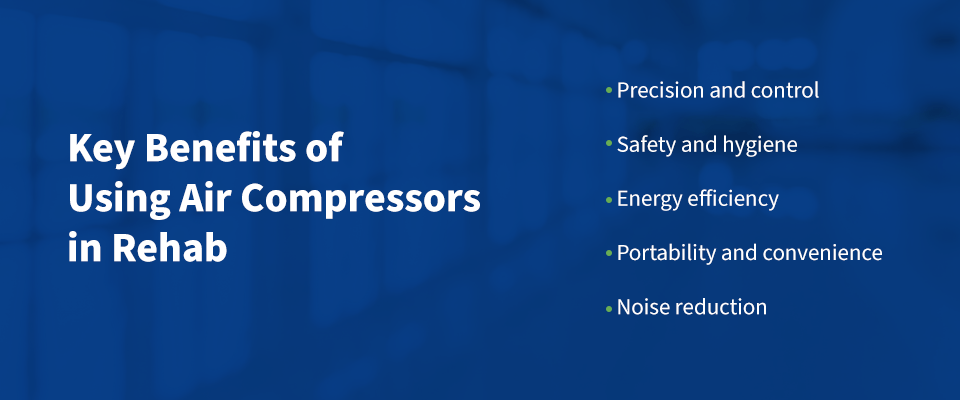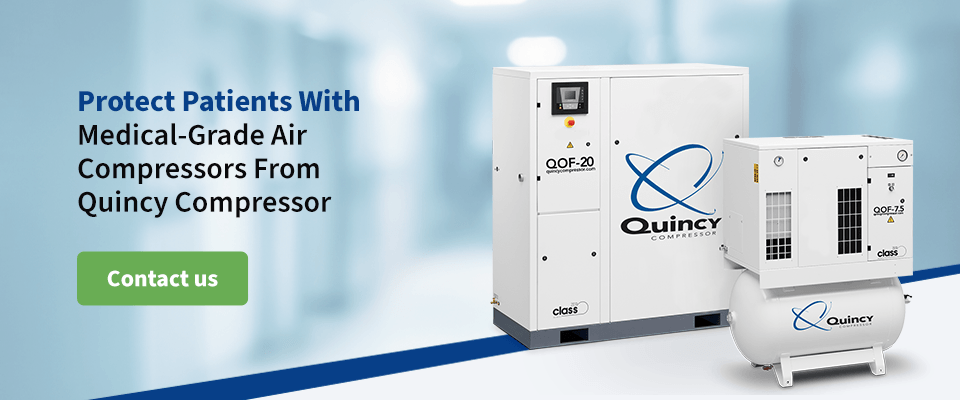Pneumatics and breathing support are vital tools for the medical rehabilitation of many conditions. Understanding how they work, and what regulations a facility must follow to ensure safe, compliant operation, is critical for patient success and continued business.
This guide explores the use of an air compressor for medical rehabilitation applications.
Uses of Medical Air Compressors in Rehabilitation Equipment
Most medical applications for air compressors use scroll compressors because they offer quiet, consistent and oil-free operation that meets International Organization for Standardization (ISO) 8573-1 requirements for air purity.
Some of the most common rehabilitative uses for medical air compressors include the following.
Respiratory Therapy
Medical air compressors are a vital component in pulmonary rehabilitation programs for patients with chronic lung conditions like asthma and chronic obstructive pulmonary disease (COPD). They power both in-office and at-home respiratory equipment, such as:
- Nebulizers: These machines use air compressors to atomize liquid medication for easy inhalation.
- CPAP/BiPAP: Air compressors power these machines to deliver pressurized air streams to patients experiencing sleep apnea and similar chronic breathing conditions.
- Ventilators: In critical rehab cases, such as spinal cord injuries and recovery from invasive surgeries, air compressors ensure consistent and reliable support for patients who need breathing assistance.
Mobility Aids
Pneumatic mobility aids use air compressors to improve comfort and adaptability for people with limited mobility. Some examples include:
- Prosthetics: Compressed air in a pneumatic prosthetic limb helps control fine motor movements like gripping and using objects. The pneumatic control system is quieter and lighter than electric prosthetics, making it a preferable option for many patients.
- Exoskeletons: Patients recovering from severe medical conditions, like strokes and spinal cord injuries, can rely on pneumatic exoskeletons and powered orthoses to help them readjust to typical occupations like walking, handling items and other complex movements.
- Adjustable wheelchairs: Inflatable air cushions on the wheelchair enable users to adjust their posture for greater comfort and prevention of pressure sores.
These devices work by controlling the flow of compressed air through a series of actuators and valves to quickly and quietly produce the desired movement.
Therapeutic Equipment
Air compressors also have various applications in physical therapy and sports medicine.
For example, pneumatic air compressor pumps and garments help relieve symptoms by intermittently applying pressure to the limbs. The pulsating pressure in the compression garment helps move lymphatic fluid and blood through the targeted area, improving circulation and reducing the risk of blood clots.
These devices are often used to manage chronic conditions like:
- Lymphedema
- Deep vein thrombosis (DVT)
- Venous ulcers
They’re also useful recovery aids for postoperative patients and injured athletes.
Diagnostic Tools
Many diagnostic tools use air compressors to diagnose patient conditions and assess progress through rehabilitation programs. Some examples include:
- Automatic blood pressure cuffs: Air compressors inflate and deflate pneumatic cuffs to ensure accurate blood pressure measurements.
- Audiometers: These devices administer carefully calibrated air pressure to measure eardrum mobility and hearing sensitivity.
- Automated cell counters: Hematology analyzers use pneumatic pressure to move samples through microfluidic channels and count blood cell content.
- Bone density scanners: DEXA scanners use pneumatics to adjust table height or stabilize other components of the machine.
- Spirometers: These devices deliver controlled pulses of air to assess lung function in patients dealing with pulmonary issues.

Key Benefits of Using Air Compressors in Rehab
Some of the most significant benefits of using air compressors in medical rehab include:
- Precision and control: Medical-grade air compressors deliver a consistent flow of pressurized air to power rehabilitation devices like ventilators and pneumatic prosthetics. This precise air supply ensures reliability and reduces the risk of a breakdown.
- Safety and hygiene: Class 1 oil-free medical air compressors deliver clean air that’s safer for patients to inhale, which is essential for breathing devices like nebulizers, ventilators and CPAP machines.
- Energy efficiency: As environmental regulations tighten across industries, minimizing an air compressor’s energy use is critical for remaining compliant with key requirements. Manufacturers are adapting to these changes by developing energy-efficient versions of traditional air compressor equipment that can help ensure more sustainable use.
- Portability and convenience: Smaller units, usually reciprocating piston or scroll-type compressors, are available so patients can continue their rehabilitation programs at home.
- Noise reduction: Scroll-type air compressors are typically quiet due to the spiral-shaped rotating scroll mechanism, which creates less noise than reciprocating pistons or rotary screws.
Requirements for Compliant Medical Air Compressor Use
Manufacturers and medical facilities must follow national and industry-wide standards, such as:
- FDA 510(k): The U.S. Food and Drug Administration (FDA) requires medical device manufacturers to submit a 510(k) for any new or modified product before it hits the market. This document demonstrates that the device is substantially equivalent to an existing device and complies with the ISO 13485 and ISO 8573-1 standards.
- ISO 13485: Manufacturers must follow these industry-specific guidelines to properly implement and maintain a quality management system (QMS) for medical device production.
- ISO 8573-1: This international standard defines air purity classes for compressed air in medical, pharmaceutical and industrial applications where air quality can have a significant impact on safety. Breathing devices like nebulizers and ventilators require air that is Class 1 or better, while other rehab devices require Class 2 or 3, depending on typical usage.
- NFPA 99: This regulation by the National Fire Protection Association (NFPA) establishes two levels of medical air compressor equipment. Level One devices are critical for patient support, while Level Two devices are not. Both levels have the same maximum dew point specification — they must remain below the frost point regardless of the current level of demand.
State Requirements
Some states impose additional regulations on air compressor use to ensure patient and operator safety. For example, Hawaii Plumbing Code section 1310.3 requires that facilities must install medical air compressors in areas that are:
- Well-lit.
- Well-ventilated.
- Clean and well-maintained.
- Accessible for maintenance personnel.
- Separate from medical gas cylinder systems.
- Provided with drainage facilities.
The code also requires each facility to have two or more air compressors to ensure continuous operations.
Protect Patients With Medical-Grade Air Compressors From Quincy Compressor
If your medical facility requires high-quality medical air compressors to provide rehabilitative treatments, Quincy Compressor can help. We have years of experience serving the medical industry, and we’ve developed various industry-specific solutions to ensure our clients can safely operate in their typical workflows.
We comply with all major manufacturing and energy use guidelines, and we have various models and configurations so you can find the exact device you need. We also offer 24/7 support for questions and service, so you can rest assured knowing your investment is supported.
View our extensive product lineup on our website, and contact us today to request a free quote for any of our air compressors.


